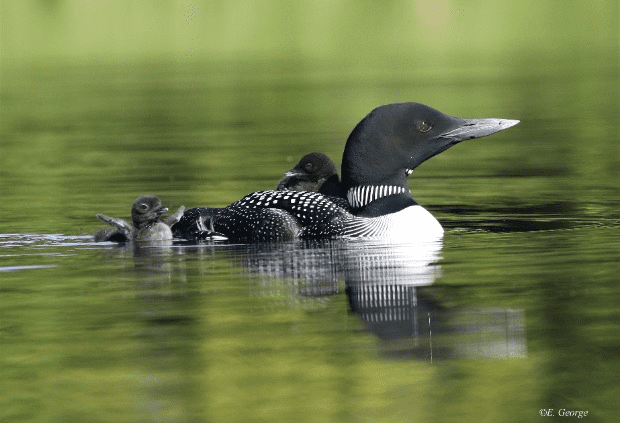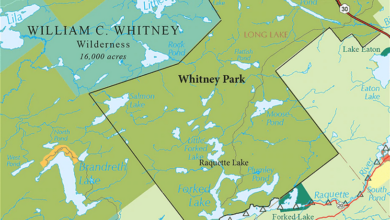Responsible Loon Watching: A Guide


 The Common Loon is an iconic species that has captivated generations of people who spend time on the lakes throughout the Adirondacks. Watching these incredible birds can be a serene and rewarding experience. However, its important to remember that like all wild animals, loons can be negatively impacted by human activities. Close approach by humans can cause loons to stop their normal behaviors that keep themselves well fed and healthy.
The Common Loon is an iconic species that has captivated generations of people who spend time on the lakes throughout the Adirondacks. Watching these incredible birds can be a serene and rewarding experience. However, its important to remember that like all wild animals, loons can be negatively impacted by human activities. Close approach by humans can cause loons to stop their normal behaviors that keep themselves well fed and healthy.
As we observe loons, we need to give them the space that they need to focus on taking care of themselves and their chicks. Here are some guidelines for enjoying responsible loon watching.
When observing loons, especially near nests or during nesting season, maintain a distance of at least 200 feet to minimize disturbance and ensure their well-being. Subtle changes in head and neck posture can indicate that a loon is concerned about how close you are.

 Keep an eye out for the behaviors described below, all of which indicate that a loon is becoming stressed and needs more space.
Keep an eye out for the behaviors described below, all of which indicate that a loon is becoming stressed and needs more space.
Raised/Squared off Brow: A nervous loon will often raise the feathers on its forehead, giving a ‘squared off’ look.
Extended Neck: A loon that is aware of or concerned about a potential threat will stretch its neck, lifting its head high in the air to better evaluate the situation.

 Sitting Low in the Water: If they detect a threat, loons will squeeze air out of the spaces between their feathers, allowing them to sink low in the water. This is an attempt to appear inconspicuous to the perceived threat.
Sitting Low in the Water: If they detect a threat, loons will squeeze air out of the spaces between their feathers, allowing them to sink low in the water. This is an attempt to appear inconspicuous to the perceived threat.
Moving Away: One of the first things that a loon will do if it is bothered by the presence of a boat is swim away. If a loon swims away from you, please allow it to get away. Pursuing/chasing loons puts them under stress.
Vocalizations: Any vocalization given by a loon when you are in close proximity can indicate that it is stressed. If loons begin to call as you approach, it is best to back away to avoid causing them more stress. Visit this website to listen to the calls of a Loon; The Wail, The Hoot, The Yodel and the Tremolo. Take a special note of the Tremolo Call as it is a definite response to a perceived threat.
Stressed Loons
The following behaviors indicate extreme stress. If you see a loon performing these behaviors, please leave the area or back away until it resumes a more relaxed position.

 Hangover Position: When nesting loons feel threatened, they will assume the ‘hangover’ position, flattening their bodies over their nests and angling their heads towards the water.
Hangover Position: When nesting loons feel threatened, they will assume the ‘hangover’ position, flattening their bodies over their nests and angling their heads towards the water.
This posture serves two purposes: First, it helps the loon to appear more inconspicuous, an attempt to ‘hide’ from a perceived threat. Second, it puts the loon into a diving position—all that the loon has to do is kick its feet and it will be back in the water, where it is more mobile and thus less vulnerable than it is on land.
Loons in hangover position may be on the verge of flushing the nest, leaving their eggs vulnerable to overheating, chilling, and/or predation. If you see a loon in this position, back away to prevent potential nest failure. And if you accidentally flush a loon off of the nest, leave the area immediately – if the threat leaves, most loons will get right back on the nest.

 Penguin Dance: If approached too closely, a loon may call and/or perform a distraction display called a “penguin dance.” When penguin dancing, loons rear up in the water with their wings either spread out or clasped against their bodies. They rapidly paddle their feet in the water to maintain this position.
Penguin Dance: If approached too closely, a loon may call and/or perform a distraction display called a “penguin dance.” When penguin dancing, loons rear up in the water with their wings either spread out or clasped against their bodies. They rapidly paddle their feet in the water to maintain this position.
This display takes a lot of the loon’s energy and indicates that the loon is very stressed. If you see this behavior, leave the area immediately.
Read more about the Common Loon in the Adirondacks.
A version of this article drawn from the Adirondack Center for Loon Conservation in Saranac Lake and the Loon Preservation Committee in Moultonborough, NH, was first published in the newsletter of the Loon Lake Park District.
Source link




